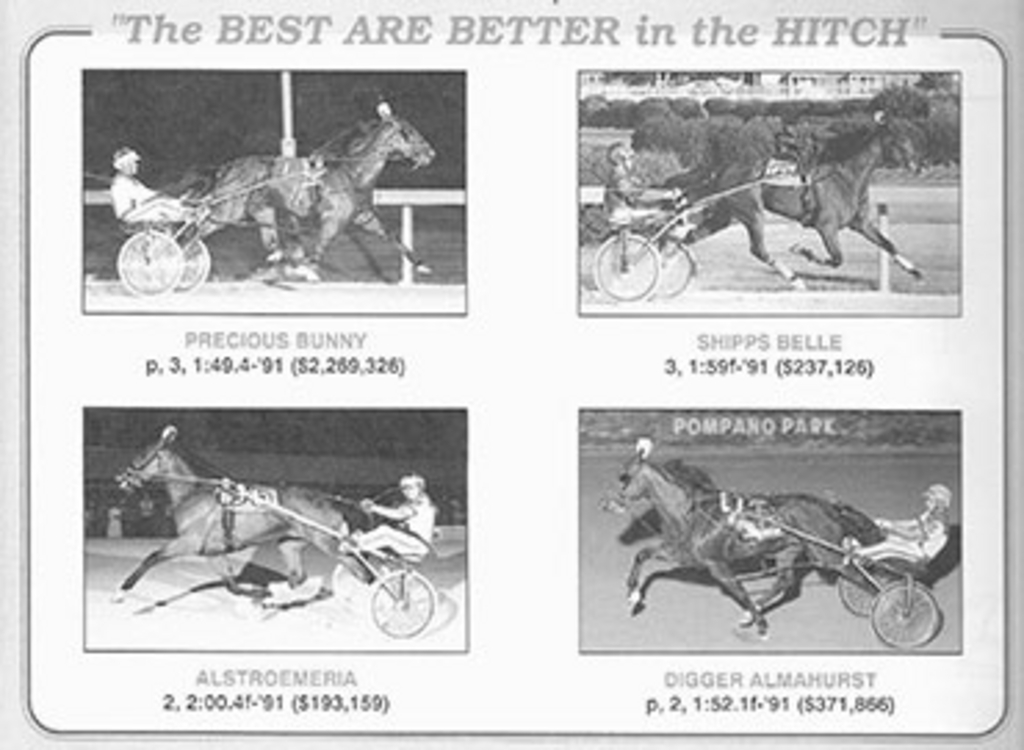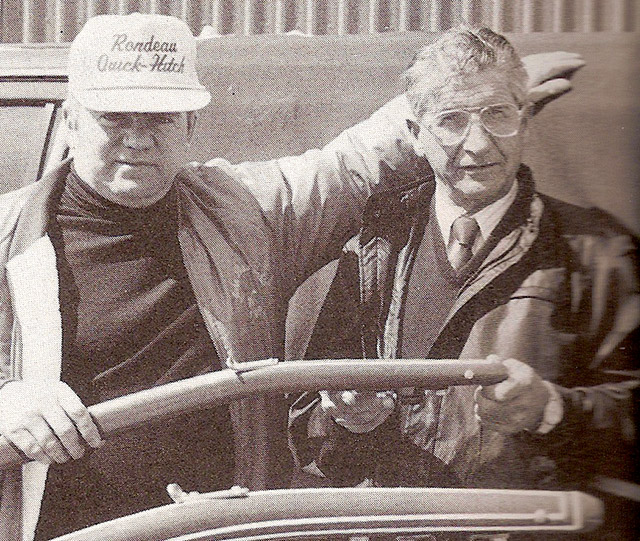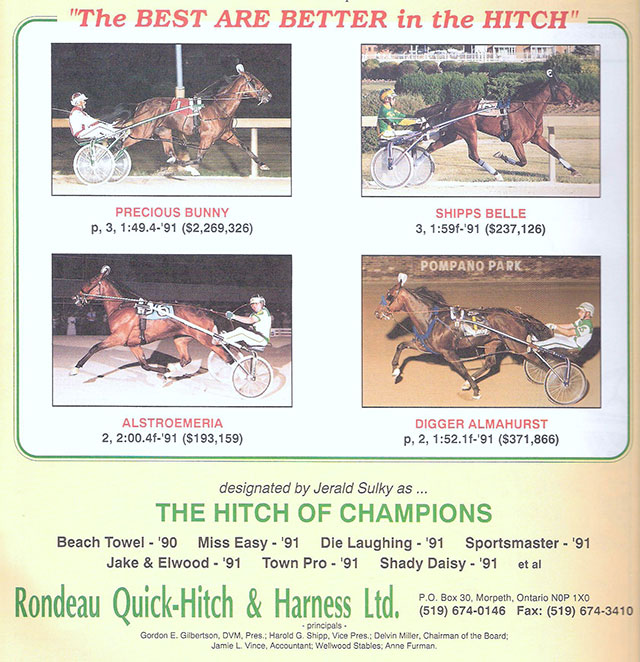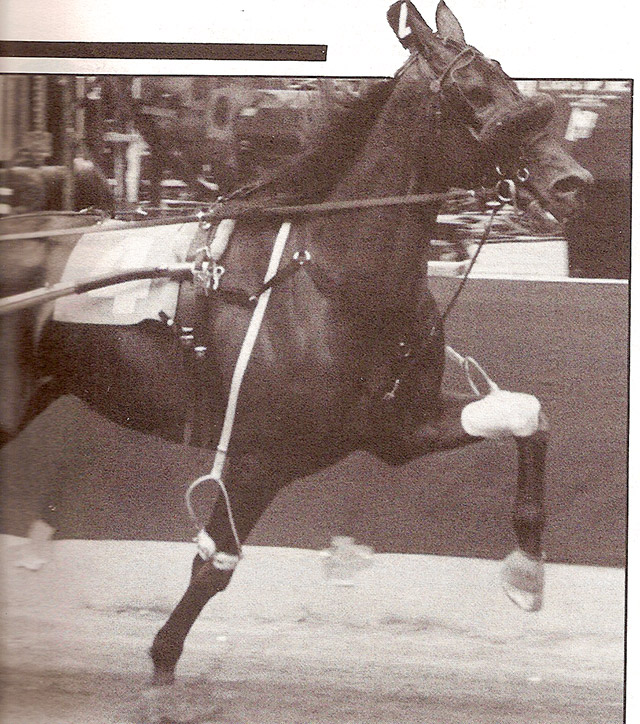
In this week's Rewind Robert Smith reviews the very long career of a most interesting man named Dr. Gordon Gilbertson. His many contributions to the sport, highlighted by an extremely important invention, place him in a rather special category.
At the age of 94, Dr. Gordon Gilbertson DVM, may very well be the sport's "eldest" elder statesman. Besides his age, he can lay claim to a lot of other interesting accomplishments from a lifetime spent in the sport. His once keen memory and his witty manner have now been dulled a bit by the passage of time, but the warmth of his smile and his gentle demeanor remains. His sometimes style of 'tell it like it is' may be in the past, but recalled by those who knew him best.
"Doc" as has logically been known for the past 70 years, was born at Hagersville, Ont., on June 3, 1920. After attending the local schools, he headed off to Veterinary college in Guelph and graduated in 1944 as a young 24-year-old . While he was trained in the traditional manner to treat all kinds of animals, his first and most enduring interest was always for horses. And so it would remain, for the rest of his life and to this day.
In pursuit of one of his early interests outside of his veterinary work "Doc" occasionally raced a horse or two on the small town Ontario circuit. In 1950 he came out with his own colt, a son of Dillon Mc named Bells Echo. He raced him with moderate success and even reached the season's top race, the Two Year Old Futurity then raced at London's Western Fair.
Around 1954 Dr. Gilbertson and his father secured a young mare from their close friend and fellow townsman Wib Slack of Hagersville. Her name was AMBITIOUS. This mare for the next eight or so years provided "Doc" with a lot of racing success. She was U.S.-bred, originating in Indiana, and was secured for a reported bargain price of $300. She was raced successfully at virtually every country fair and small town track in the area and then taken to the U.S.
The pair raced frequently at the popular tracks of the day in New York State, namely Buffalo and Batavia. Then in 1960 Doc decided to follow a popular trend of the day for those looking for a fast clocking. He journeyed to Vernon Downs and Ambitious went a career mile, stopping the timer in 2:03 with "Doc" in the bike. Vernon's 3/4 mile track, where the horses scored out of a chute, helped a lot of horses to new records. That was quite a mile in those days and created a tale that Doc often retold. In her racing career Ambitious earned a respectable $30,000 in purses which was pretty good for the times.
Dr. Gilbertson worked at his calling in a number of different fields and he also was not adverse to moving when the spirit "moved" him. At various times in his long career his address changed. A few of his stops included Caledonia, Dundalk, Burford, Harrow, Peterborough, London, Morpeth and even a short time in Indiana. In 1965 he became the first track vet at the then brand new Windsor Raceway. Also in addition to his ongoing private practices, he worked for the Ontario Racing Commission for many years. While resident in Morpeth he was closely allied with the Agricultural College at Ridgetown. I was fortunate at one of his stops nearly 50 years ago to get to know "Doc" a bit as well as his wife Eleanor. Currently they reside at Stratford.
In what might well be considered the twilight of his career, Dr. Gilbertson "stepped out of the box" and distinguished himself, not by his veterinary talents but rather by his unique invention. It was a major undertaking to say the least, with lasting effects.
Around 1978, Dr. Gilbertson began to act on a "dream" and an idea that had been on his mind for quite some time. Based on his extensive experience of both treating horses as well as hands-on experience in training and driving harness horses fuelled his idea. In a 1988 interview with Sulky Magazine he stated "I had long considered the idea of eliminating the shaft points of the sulky as a safety measure and also to reduce the rubbing or irritation to horses . The problem was to find a way of engaging the shaft at the saddle of the harness".
Dating back to the earliest times an antiquated system of attaching a horse to a sulky involved using a "thimble" placed over the shaft ends and then wrapping straps around the straight portion of the shaft had been in use. "Doc" knew there was a better way and above all a safer way. He set about transferring his idea from theory to reality and fashioned a prototype from machined parts secured from various sources. In 1980 he secured Canadian and U.S. patents on his new "Quick Hitch" which would eventually be called "Rondeau Quick Hitch". The name chosen was a reference to the area where he lived in Kent County.
His next step was to have endorsements to protect the patent. In the same Sulky article referred to earlier he also stated "I don't want to spend the rest of my life, and all of my resources fighting infringement." He quickly drew the attention and the backing of the sport's top people. Early in the endeavour he sought out the great U.S. horseman and innovator Delvin Miller, a man who had been often involved in effecting change. Doc recalled the words of Miller who at the end of their first meetings said "Doc, it's a good thing somebody's thinking..."
Miller not only gave his verbal blessing and approval of Doc's idea, he set a new world record with his own trotter Tarport Ramey -- equipped with the "Rondeau Quick-Hitch". For those who do not remember Delvin, he was not a person prone to idle chatter nor was he one who wasted time on unsound ideas.
Soon a number of other people influential in the sport subscribed to Gilbertson's new invention and Delvin Miller was named Chairman of the Board as the new Company was incorporated on Sept. 2, 1987. In an equally important move Mr. Harold Shipp, a Mississauga businessman and standardbred owner became Vice President and shared ownership of the new enterprise 50-50 with Gibertson. Fittingly his horses, trained by John Burns, all began to use the Quick-Hitch and he soon became an effective spokesman for the product. The name Shipp was not only synonymous with the finest in home construction, he also owned a stable of top notch harness horses.
After a number of slight modifications, the proof of the new idea soon grew. Top horsemen such as Bill Wellwood, Doug Hie and several others totalling 80 trainers became "converts". Not only Canadians were at the forefront, but U.S. horseman Mark O'Mara who decided to use the new hitch on Jate Lobell in the 1987 North America Cup as he felt it helped to negotiate the Greenwood turns. The decision proved to be a wise one as the O'Mara entry defeated Frugal Gourmet in a thrilling stretch drive, stopping the timer in 1:52.4.
Training centres in New Zealand, North America and Europe quickly began to accept the new hitch. The idea of a "Quick Hitch" and its ascension to reality confirmed that the small Town vet was literally indeed on the right track.
Today some 35 years after "Doc" first unveiled his new invention, either his exact product or spinoffs are in use around the globe. The once cumbersome, ineffective and dangerous apparatus in use for centuries is now seen only in old photographs. His idea is so much a part of the modern day harness rigging that it seems as though it has been here forever.
Despite his countless hours of work and thousands of miles of travel in pursuit of his dream, many believe that he has seldom been given the proper acclaim, and that worse yet he has never been financially rewarded. Whatever the view or the opinions people may have, he certainly has had a huge impact on the growth and modern day development of the sport of harness racing as a whole.
While Dr. Gordon Gilbertson may not have been a world class vet or voted the sport's greatest horseman, few can deny that his invention was unquestionably one of the absolute best ever.

Dr. Gilbertson right joins with trainer John Burns in displaying the new modified sulky shafts built to accommodate the then new "Quick Hitch" apparatus.

A racing journal ad from 1991 displays a short list of horses using the Rondeau Quick Hitch and also the people involved in the Company

Tarport Ramey and driver Delvin Miller setting a new world's record using the revolutionary Rondeau Quick Hitch system designed by Dr. Gordon Gilbertson


It was great hearing about
It was great hearing about Gord. He is a long time friend. I can still remember Gord making his way to my barn in Dresden with cart and harness for me to try out. It is great that we have taken the time to look back at the good old days. Lyle Grineage
It's nice to finally see Doc
It's nice to finally see Doc recognized, certainly his quick hitch had a big impact on racing. It also saved a lot of time for trainers. I remember the day when Doc gave my father a set of quick hitches to try out on his show ponies and it worked well for training. Doc was our home vet and was always there when we needed him. it would be nice to see him recognized in the hall of fame.
Just a great article on one
Just a great article on one of the most innovative inventions in harness racing, equal to the invention of the mobile starting gate. So why is it that this man, although having been nominated on numerous occasions for the Cam Fella Award (in the builders category), has never gained the recognition that he so rightly deserves. A little history..... Early on, Doc brought his "quick hitch" to the Rodney Fairgrounds where I happen to be training at the time to use and experiment with. He told me that I was only the second trainer in the area to be given the opportunity to try one. After having used it, I liked it so much and I flatly refused to give it back to him. I knew that this new hitching system had merit. Bill Wellwood like it and said it was "groom proof". By that, he meant that his horses were hitched the same way all the time. Because of his invention, I personally nominated Dr. Gilbertson, as did several other fellow horseman, for the Cam Fella Award, only to be denied. I think it's about time that we righted this injustice and honour him for his great contribution to harness racing.